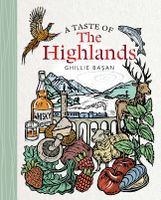Advertisement
Juniper
Published 2021
The fruit, or cone, of the evergreen juniper bush in the Highlands is green in its unripe form but doesn’t actually ripen until the following year when it turns navy blue, almost deep purple. This means you can have green juniper berries all year round and sometimes have both green and blue on the same branch, but the ripe ones are usually harvested in the autumn. There are old accounts of people beating the juniper bushes with a stick and catching the falling berries in a cloth spread beneath. A tea made with the berries was thought to be a good diuretic and the eating of a few berries every morning was said to be as good as a dram. Branches of juniper were sometimes hung above doors and windows on auspicious days to ward off evil spirits and they were burned to produce a light smoke, which was carried through the house to cleanse it of bugs and disease. When juniper berries are ripe they are rich in oil and slightly sweet so they are often picked at this stage to flavour gin, to dry as a spice for marinating and pickling, and for cooking fish and game. I also grind the dried ripened berries with salt to keep as a flavoured seasoning. The green berries are sharp and juicy, slightly nippy on the tongue, so I use them for dressings and pastes and to make green juniper cream, a deliciously tangy gin-flavoured condiment.


